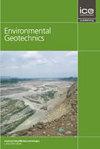1D Damage constitutive model and small strain characteristics of fly ash–cementitious iron tailings powder under static and dynamic loading
IF 2.2
4区 工程技术
Q3 ENGINEERING, GEOLOGICAL
引用次数: 0
Abstract
With the vigorous development of industrial economy, the production capacity and level have been significantly improved, but at the same time, a large number of iron tailings, fly ash and a series of bulk solid waste materials have been accumulated. These industrial wastes have caused serious impact on the ecological environment. How to deal with them effectively is an urgent problem to be solved. The aim of this study was to investigate the effect of cement and fly ash compound admixtures on the mechanical properties of iron tailings powder (ITP). Hence, different mixing ratios of cement and fly ash were used to prepare two kinds of ITP-based materials. A range of uniaxial compressive strength (UCS), resonance column (RC), scanning electron microscopy (SEM), and X-ray diffraction tests were conducted to investigate the roles of cement, fly ash, and curing age on ITP solidification. A random 1D damage model was imported to study the damage evolution of ITP materials using the UCS and RC test results, which showed that cement and fly ash enhanced the unconfined compression strength and small strain stiffness of iron tailings powder. When 5–10% fly ash content was a substitute for 10% cement, the unconfined compressive strength and small strain modulus of the cement–fly ash–iron tailings powder increased with curing age. The microstructure and mineralogy analysis confirmed that fly ash enhanced the strength of the material. Overall, the damage constitutive model effectively represented the randomness of the compressive strength and stress–strain relationship of ITP materials under unconfined conditions.粉煤灰-胶凝铁尾矿粉在静、动载荷作用下的一维损伤本构模型及小应变特性
随着工业经济的蓬勃发展,生产能力和水平得到了显著提高,但同时也积累了大量的铁尾矿、粉煤灰和一系列散装固体废物。这些工业废弃物对生态环境造成了严重的影响。如何有效地解决这些问题是一个亟待解决的问题。研究了水泥与粉煤灰复合外加剂对铁尾矿粉力学性能的影响。因此,采用水泥与粉煤灰的不同配比制备了两种itp基材料。通过单轴抗压强度(UCS)、共振柱(RC)、扫描电镜(SEM)和x射线衍射测试,研究了水泥、粉煤灰和养护龄期对ITP固化的影响。引入随机一维损伤模型,利用UCS和RC试验结果研究ITP材料的损伤演化,结果表明,水泥和粉煤灰增强了铁尾矿粉的无侧限抗压强度和小应变刚度。当粉煤灰掺量为5 ~ 10%时,水泥-粉煤灰-铁尾矿粉的无侧限抗压强度和小应变模量随龄期的增加而增大。微观结构和矿物学分析证实,粉煤灰增强了材料的强度。总体而言,该损伤本构模型有效表征了无侧限条件下ITP材料抗压强度和应力应变关系的随机性。
本文章由计算机程序翻译,如有差异,请以英文原文为准。
求助全文
约1分钟内获得全文
求助全文
来源期刊

Environmental geotechnics
Environmental Science-Water Science and Technology
CiteScore
6.20
自引率
18.20%
发文量
53
期刊介绍:
In 21st century living, engineers and researchers need to deal with growing problems related to climate change, oil and water storage, handling, storage and disposal of toxic and hazardous wastes, remediation of contaminated sites, sustainable development and energy derived from the ground.
Environmental Geotechnics aims to disseminate knowledge and provides a fresh perspective regarding the basic concepts, theory, techniques and field applicability of innovative testing and analysis methodologies and engineering practices in geoenvironmental engineering.
The journal''s Editor in Chief is a Member of the Committee on Publication Ethics.
All relevant papers are carefully considered, vetted by a distinguished team of international experts and rapidly published. Full research papers, short communications and comprehensive review articles are published under the following broad subject categories:
geochemistry and geohydrology,
soil and rock physics, biological processes in soil, soil-atmosphere interaction,
electrical, electromagnetic and thermal characteristics of porous media,
waste management, utilization of wastes, multiphase science, landslide wasting,
soil and water conservation,
sensor development and applications,
the impact of climatic changes on geoenvironmental, geothermal/ground-source energy, carbon sequestration, oil and gas extraction techniques,
uncertainty, reliability and risk, monitoring and forensic geotechnics.
 求助内容:
求助内容: 应助结果提醒方式:
应助结果提醒方式:


